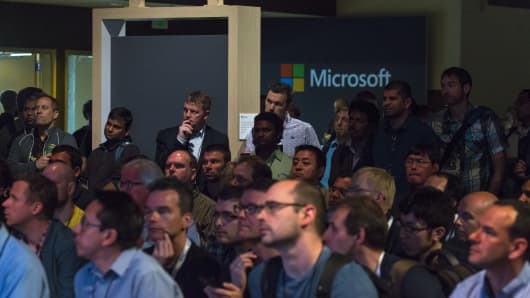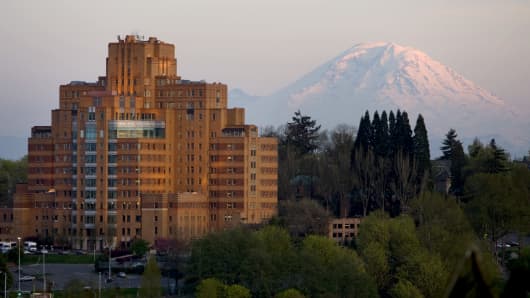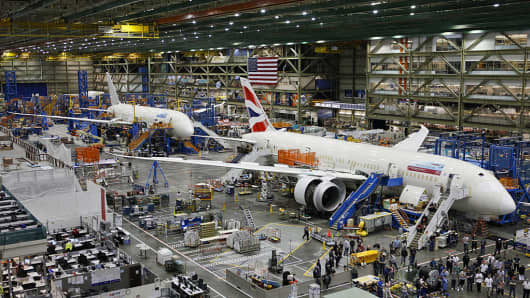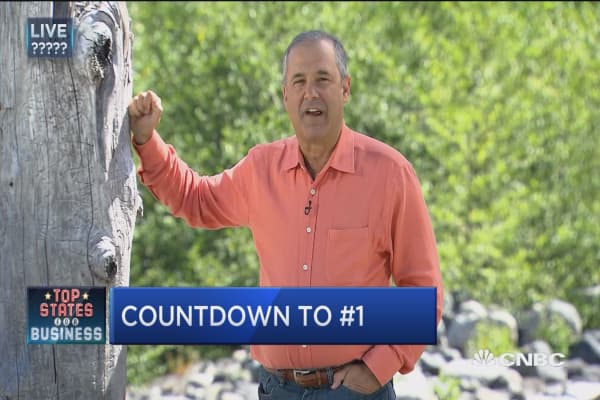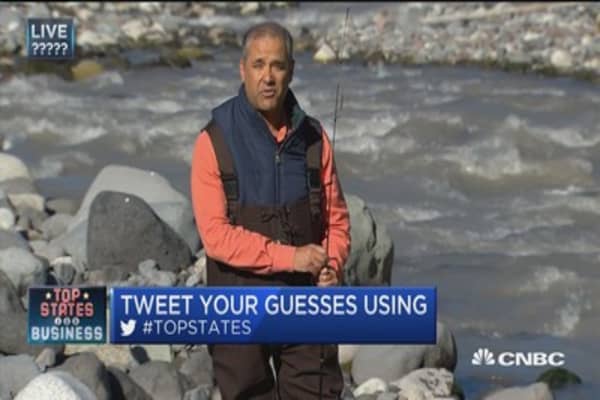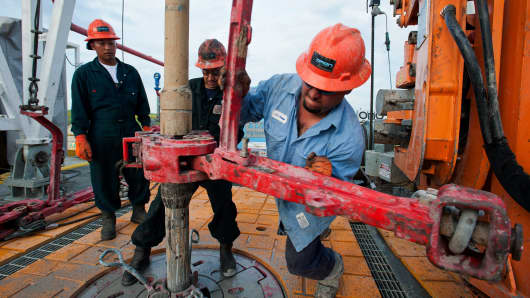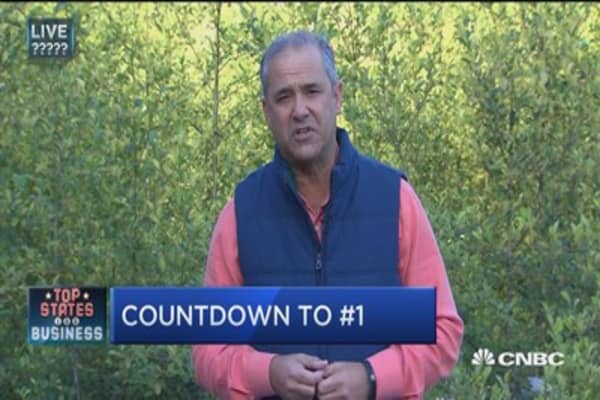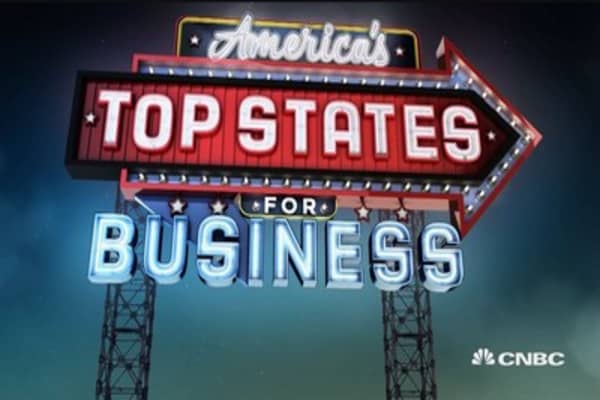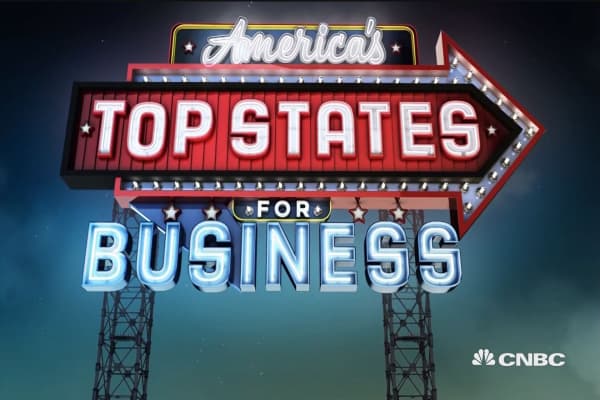 With the nation’s fastest-growing economy and an all-star business roster of household names and up-and-comers, Washington — the Evergreen State — soars above the competition as America’s Top State for Business in 2017.
With the nation’s fastest-growing economy and an all-star business roster of household names and up-and-comers, Washington — the Evergreen State — soars above the competition as America’s Top State for Business in 2017.
The home of Amazon and Costco, Boeing and Expedia, as well as rising stars like Adaptive Biotechnologies, online marketplace OfferUp and space company Blue Origin, Washington has the old and new economies covered — as well as pretty much everything in between.
But the success story does not end there. At a time when the best workforce rules, Washington boasts the nation’s largest concentration of STEM (science, technology, education and math) workers. Nearly 1 in every 10 Washington workers is in those professions, according to the U.S. Bureau of Labor Statistics. The University of Washington’s computer science school — recently named for one of the university’s most famous alumni, Microsoft co-founder Paul Allen — is world class. There is no brain drain here; no state does better at hanging on to its college graduates. And the state is consistently a magnet for investment capital. Washington businesses attracted nearly $1.6 billion in venture capital last year, the sixth-highest total in the nation.
Washington climbs to the top of our rankings this year with 1,621 out of 2,500 points, including top 10 finishes in five of our 10 categories of competitiveness. As always, we score all 50 states using 66 metrics across those 10 categories. Using our tried-and-true methodology, we assign a weight to each category based on how frequently the states use them as selling points in their economic development marketing pitches.
This year’s categories and point totals are:
- Workforce: 425 points
- Infrastructure: 400 points
- Cost of Doing Business: 350 points
- Economy: 300 points
- Quality of Life: 300 points
- Technology & Innovation: 225 points
- Education: 200
- Business Friendliness: 150 points
- Access to Capital: 100 points
- Cost of Living: 50 points
Washington’s first-place finish culminates a steady ascent since the state first cracked our top 10 in 2014 — the same year the Seattle Seahawks won their first and only Super Bowl. Also that year, Gov. Jay Inslee told legislators, “Washington’s outstanding workforce is our state’s greatest asset.”
Since then, that workforce has been outdoing itself.
Washington’s economy grew 3.7 percent in 2016, the largest increase of any state and nearly two and a half times the national rate. That, along with solid job growth and one of the hottest housing markets in the country, wins the state a No. 3 finish in our Economy category.
Washington also finishes No. 3 in Technology & Innovation. Only Californians received more patents last year, and Washington institutions were among the largest recipients of medical research grants. All those smart workers help the state finish No. 5 in the important Workforce category. The state also finishes No. 5 for Quality of Life and No. 8 for Access to Capital.
Education a sore spot
But all is not perfect here. The state is under orders from its own supreme court to adequately fund its 19th-ranked education system. The state has been paying fines of $100,000 per day for every day without a plan that complies with the state constitution. The fines began in 2015.
More for America’s Top States for Business
State winners and losers in competition to win corporate deals
Why this is the bottom state for business
America’s Top States for Business in 2017
Washington is also notoriously expensive. Even though the state has no individual or corporate income tax, it finishes No. 37 for Cost of Living and No. 32 for Cost of Doing Business. With the average worker earning $26.83 an hour, according to the U.S. Bureau of Labor Statistics, Washington wages are the eighth highest in the country. And with office space going for more than $26 per square foot, according to the CoStar Group, rent is the sixth highest.
In the increasingly important Infrastructure category, Washington lands in 32nd place. Two-thirds of the state’s roads are in mediocre or poor condition, according to the U.S. Department of Transportation.
All of the failings prove that despite Washington’s strong competitive position, it is not immune to the polarization gripping the rest of the country. State government in Washington is about as divided as can be. Gov. Inslee is a Democrat, and Democrats narrowly control the House of Representatives, 50–48. But Republicans control the state Senate by a single vote, 25–24. No wonder that it took three special sessions for Gov. Inslee and the legislature to reach an agreement on a new budget, narrowly averting a government shutdown on July 1. The new budget relies primarily on higher property taxes to increase school funding, raising more than $7 billion over four years and, the legislature hopes, finally complying with the Supreme Court order.
An even bigger concern for the state is whether the recent pace of growth is sustainable. The state’s largest employer, Boeing, has cut more than 8,400 jobs in Washington in the past year. That has prompted “I told you so’s” from critics of the generous subsidies the state has provided the company, as well as broader concerns about whether Washington’s competitive position has peaked.
A rise to the top
Our 2017 field of Top States is our most competitive since we began ranking the states more than a decade ago. Washington outranks its nearest competitor by a mere five points. And second-place Georgia outscores third-place Minnesota by a single point.
Georgia and Minnesota illustrate a running theme in our study year after year: There is no exclusive path to competitiveness.
Georgia follows a more traditional route, the one typically favored by business, emphasizing lower taxes and fewer regulations. The state has come roaring back from the Great Recession, which hit Georgia hard. Now it has the best all-around economy in the nation, according to our study. But it falls seriously short in two categories that often benefit from more state support: Education, where it finishes No. 33, and Quality of Life, where it finishes No. 28.
By contrast, Minnesota takes the position that you get what you pay for. The North Star State finishes No. 2 for Education and No. 3 for Quality of Life. And the state is no slouch in the Economy category, finishing No. 6 with the help of a solid housing market and strong state finances. But the state finishes No. 36 for Cost of Doing Business and No. 31 for Cost of Living. State taxes — at least as far as the top brackets go — are among the highest in the country.
Culture clash
Our 2017 study marks the first time since our rankings began in 2007 that Texas has fallen below second place, dropping to No. 4 this year. In that sense, it is a remarkable drop for a three-time Top State (2008, 2010 and 2012).
The biggest factor in Texas’ slippage is its economy, which plummets to No. 25 this year from No. 1 last year. And the biggest factor in the Texas economy is the price of oil.
While prices have bounced back somewhat, they are still well off of their 2014 highs and roughly 70 percent below their peak before the 2008 financial crisis. That has led to some difficult budget decisions in Austin. The blow is cushioned somewhat by the state’s strong reserves, a decades-long push to diversify and a tentative return to Texas-style GDP growth at the beginning of 2017.
But Texas gets low marks when it comes to Quality of Life, where it repeats at No. 37 this year. The state has the lowest percentage of people without health insurance—17.1 percent, according to the U.S. Census Bureau—a fact that state policymakers ascribe to personal freedom, but one that affects Texas residents or would-be residents nonetheless.
And despite widespread outcry from business groups, Texas remains 1 of only 5 states with no statewide antidiscrimination protections for non-disabled residents. Inclusiveness counts in our study, where we consider it a factor in Quality of Life. This year’s biennial session of the state legislature has been marked by multiple proposals aimed at making the state even less inclusive.
Another state without such protections is North Carolina, which finishes No. 5 overall for a second straight year. In the face of a nationwide business backlash, the Tar Heel state this year repealed its so-called bathroom bill, which restricted transgender people’s use of public facilities. But even as it repealed the law, the state affirmed its prohibition of local antidiscrimination ordinances.
Some businesses and events that had boycotted the state over H.B.2 — like the NCAA Men’s Basketball Tournament — decided to return anyway, and North Carolina does improve to No. 28 from No. 30 last year in Quality of Life. But the state remains among the least inclusive in the nation. That partially cancels out some of North Carolina’s big advantages, including its No. 7 Workforce and its No. 6 finish for Technology & Innovation.
Indeed, for a second year in a row, both North Carolina and Texas might have finished at or nearer to the top of our rankings had either state decided to be a bit more welcoming to workers.
Changing state dynamics
This year’s most improved states — a three-way tie — are all in the Northeast, each jumping 10 spots in our overall rankings this year. But beyond the numbers, the stories of Massachusetts, Pennsylvania and Connecticut are very different.
Massachusetts’ jump lands the Bay State in the Top 10 for the first time since 2011. The state logs solid improvement in Quality of Life (tied for No. 10 vs. No. 17 last year), Economy (No. 14, up from No. 18) and Access to Capital (No. 7, up from No. 19). The state is a perennial leader for Education and Technology & Innovation, but high costs and poor infrastructure ultimately hold Massachusetts back from true Top State status.
Pennsylvania, which moves into the top half at No. 23, posts the best all-around improvement. The Keystone State moves higher in five categories: Workforce (up 8 spots to No. 21), Economy (up 8 spots to No. 34), Education (up 11 spots to No. 10), Business Friendliness (up 7 spots to No. 28) and Access to Capital (up 7 spots to No. 5). It is the state’s best overall ranking in six years.
Connecticut’s 10-place move takes it out of the bottom 10, but the Constitution State still finishes a disappointing 33rd. Connecticut owes much of its improvement to a big jump in its Education ranking, climbing to No. 3 from No. 18, due largely to better high school test scores. But the state is in a budget crisis, with school funding a central issue as Gov. Dannel Malloy seeks to overhaul the state formula to redistribute money to districts in need. Meanwhile, Connecticut does poorly in Infrastructure (No. 47), Cost of Doing Business (No. 43) and Cost of Living (No. 45). With a number of high-profile companies leaving or thinking of leaving the state, a No. 33 finish in our Top States rankings is what passes for good news in Connecticut these days.
The biggest move in the other direction is Wyoming, which plunges 14 spots to No. 27 after the state’s resource-rich economy practically ground to a halt last year amid low commodity prices.
That also helps explain a new Bottom State for 2017. Suffocating under the weight of declining coal production, West Virginia falls to No. 50 from No. 47 last year. Other states bringing up the rear are No. 46 Maine, No. 47 Alaska, No. 48 Mississippi and No. 49. Hawaii.
Notice something missing from the bottom five? That would be Rhode Island — just barely. The state is still something of a mess, with high taxes, sky-high utility bills and America’s worst infrastructure. But efforts by the Ocean State to improve itself are paying off in a stronger economy. Rhode Island’s 45th-place finish is the best it has ever done in our study.
Each year, our Top States for Business study sparks plenty of debate and important conversations about what it takes to make a state competitive. Register your comments here, and on social media using the hashtag #TopStates.
[“Source-cnbc”]




